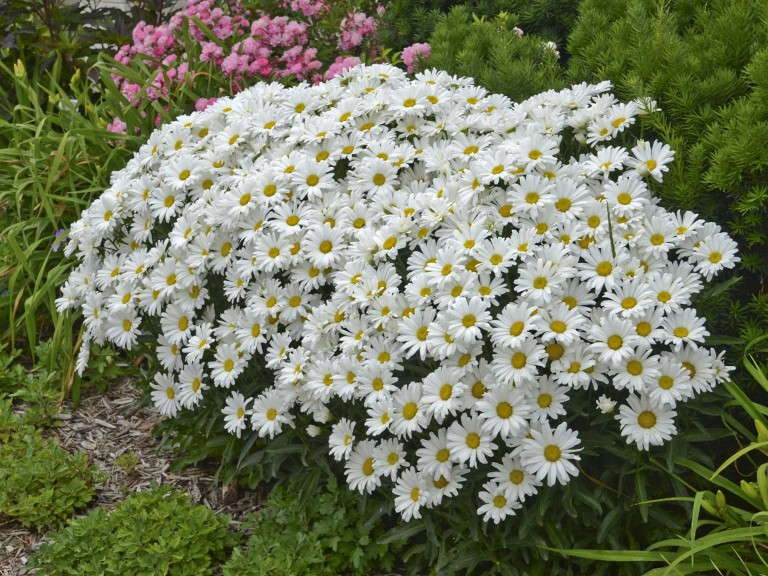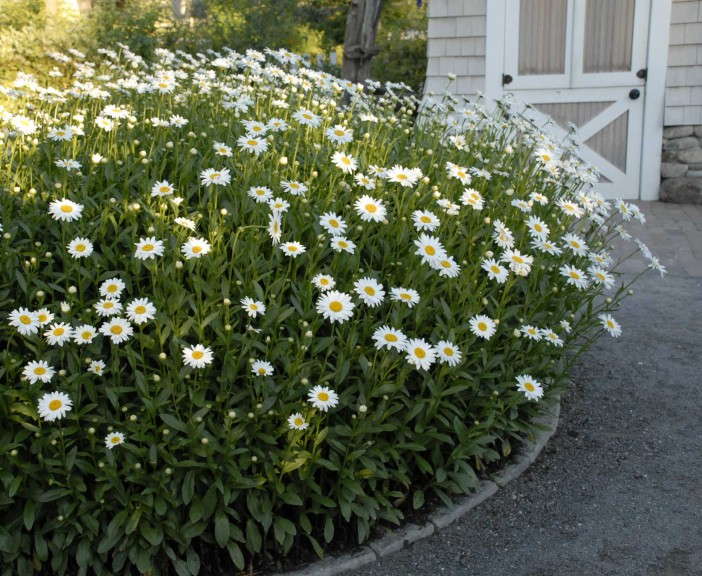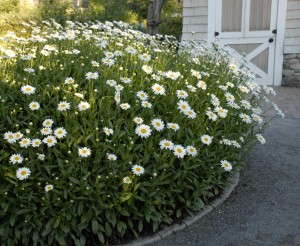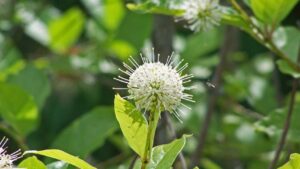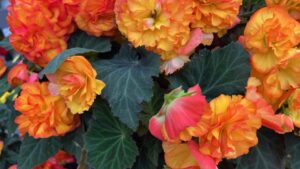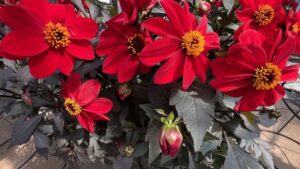Tips for Finishing Leucanthemum Successfully

Leucanthemum ‘Daisy May’
Leucanthemum is a staple item for every perennial assortment. There are many varieties, from the very short ‘Snowcap’ to the long-legged beauty ‘Becky.’ Light yellow selections such as ‘Banana Cream’ have also become available over the last few years. The gold standard in white Shasta daisies is ‘Daisy May,’ prized for its perfect knee-high habit, its ability to rebloom multiple times throughout the growing season and its shorter vernalization requirement. Here are a few tips to help you grow leucanthemum successfully.
Potting And Timing
Growers who are looking to sell large, full, heavily flowering specimens of leucanthemum should start them from small plugs in late summer the year prior to sale. Fresh, 72-count plugs planted into premium 1-gallon containers in late summer will need eight to 10 weeks to finish before winter arrives.
If late summer planting is not possible, growers should start with larger plugs planted in spring. Vernalized 30-count plugs planted into premium 1-gallon containers will need six to eight weeks to finish.
Plant leucanthemum plugs into a well-drained peat/bark/perlite soil mix with a pH of 5.8 to 6.2 for best results.
Cultural Recommendations
Fertility
Leucanthemum is a moderate feeder, generally requiring 75 to 150 ppm nitrogen using a constant liquid feed or 1 to 1 ½ pounds nitrogen per yard of growing media of slow release fertilizer. However, growers will learn as they produce different varieties of leucanthemum that some will prefer heavier feeding and others will not need as much.
It is good practice to monitor fertility levels throughout the growing process and make adjustments as you see fit. Also monitor salt levels and maintain an EC of 2.0 to 3.0 using the pour-through method.
Moisture
Leucanthemum prefers moderate to moist soil. Never let the plants dry out, as this will stunt their growth and fewer flowers will be produced. If using overhead watering, irrigate in the morning so the foliage is dry by evening to prevent diseases from settling in.
Lighting
Leucanthemum requires high light intensities to grow well. In the greenhouse, grow them under clear plastic rather than white plastic. During their natural growing season, supplemental lighting should not be necessary. However, if you are forcing them to bloom earlier, note that long days (16 hours) are necessary to initiate flowering and supplemental lighting will be needed to provide these conditions.
Temperature
The ideal temperatures for growing leucanthemum in spring are:
• Rooting temperature: 65°F to 72°F
• Growing/bulking temperature: 55°F to 65°F
• Holding temperature: 40°F to 50°F
If growers are not able to provide such growing conditions, alternatively leucanthemum can be grown at 65°F to 68°F until finished and then held at 40°F to 50°F.
Pests And Diseases
Leucanthemum is relatively carefree if grown under the proper conditions. It is always a good idea to scout for aphids, whiteflies and thrips and treat as needed. If grown under poor conditions, diseases such as botrytis, crown gall, powdery mildew and septoria can become an issue. To help prevent disease, water in the morning, provide good air circulation and space plants properly.
Finishing Tips
When potting leucanthemum plugs in spring, be sure they have been vernalized for at least six to 10 weeks. Likewise, when planting fresh leucanthemum in late summer, be sure to provide a six- to 10-week vernalization in order for plants to flower well the following spring. One advantage of growing ‘Daisy May’ is that it only requires four weeks of vernalization to flower profusely. This is a key advantage, particularly for southern growers.
Be sure to space plants well when finishing leucanthemum in order to form well-rounded, uniform plants and to prevent disease.
Pinching And PGRs
When potting leucanthemum up in late summer from small plugs, do a soft pinch at time of transplant and again two to three weeks later if needed. This will help to promote lateral branching and result in more well-rounded finished plants.
Varieties that tend to bloom heavily at a young age like ‘Daisy May’ will need to have their flower stems pinched out of the young plugs until the plants are fully bulked up in the containers. You do not want the plants to flower before they are finished.
Taller varieties of leucanthemum like ‘Becky’ may benefit from PGRs to keep them looking neater in the pot. If you choose to use PGRs, northern U.S. spray rates are 2500 ppm of daminozide (sold as B-Nine or Dazide) or 5 ppm of uniconazole (sold as Concise or Sumagic). Rates may be higher in the southern U.S. The recommended application frequency is one to two applications at seven-day intervals when the flower stalks are beginning to elongate.
Forcing
Finished containers of vernalized leucanthemum are best forced into flower at cool temperatures (60°F) for approximately 10 weeks. Plants forced under these conditions will naturally be more compact and have larger flowers. Growers wishing to minimize forcing time can force plants in warmer (70°F) temperatures for six to eight weeks. However, the tradeoff will be smaller flowers and PGRs may be necessary to control stretching.
To force ‘Daisy May’ into flower for Mother’s Day sales, plant one 72-count plug per premium 1-gallon container in late summer and finish before winter arrives. Allow a minimum of four weeks vernalization for ‘Daisy May.’ In late February or early March, warm the plants up to 60°F and use supplemental lighting to provide 16-hour days for approximately 10 weeks. This should bring them into flower by early May.
Visit the Walters Gardens website for more grower tips.
[blackoutgallery id=”56096″]




